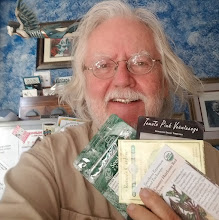 In the Garden, on our youngest cotton tree, you can see the distinctive leaf shape and, somewhat obscured, an open cotton boll waiting to be picked. Only a few feet away on the right, pedestrians hurry on their way never noticing this little wonder.
In the Garden, on our youngest cotton tree, you can see the distinctive leaf shape and, somewhat obscured, an open cotton boll waiting to be picked. Only a few feet away on the right, pedestrians hurry on their way never noticing this little wonder. I have spent some moments today with cotton seeds. We are growing two types of cotton here at the Garden, one is the usual cotton grown in the large fields of many southern states and the other is ignored by our culture altogether, a cotton tree. I wanted to ascertain how many seeds I had for the cotton tree so a class could learn to grow seeds using these.
Both our cottons are species of the Gossypium genus. The tree is G. arboreum while the annual plant is probably G. hirsutum, from which about 90% of the world's cotton fabric comes from. I understand that other civilizations have used the cotton tree for fabric (and may well still), but in our culture, the mow, blow and go culture, we have always preferred the annual plants for production for the most part. We like to plant our field with a crop in nice long straight rows and then when it's all ripe, come in and grab it all and run off to the next project. Mind you, this is the 'efficient' way of doing things, although, I would contend that we've given a lot of ourselves away in order to pacify the God of Efficiency and have gotten more trouble for our effort than we often care to admit.
I won't postulate that we give the annual cotton up, but I would suggest that many folks could find happiness with a cotton tree. It will never be a cotton of commerce because it bears a little here, a little there and would drive an agribusinessman out of his mind. But a person who would like to spin some cotton and maybe make some things from cotton, this might be the absolute ticket. After a few years, a couple of trees could make one very happy.
At The Learning Garden, we have several young cotton trees. At this point, the oldest is no more than three years old. Yet we picked a goodly amount of cotton from it – probably not enough to make much more than a wash rag or a wash towel, but, they are young. And on their own for all practical purposes; they don't get watered or cared for especially well.
Our cotton trees are no more than five feet tall right now, but The Huntington has the same species and theirs is over twelve feet. I have seen it with more cotton on it than we get on our two in a full year. The production ability is there to produce enough cotton to make a thing or two from one tree.
I don't know how hardy this species is – we are in USDA Zone 12 which isn't very challenging as far as cold goes, and we are so close to the ocean we aren't really that challenged for heat either. The one at the Huntington does experience an occasional frost and certainly has to deal with warmer weather than we have, so I'm thinking it's safe to consider it to about Zone 9, but then again, I play the lottery, you might want a second opinion.
In separating seeds from the cotton bolls, I did find the annual cotton to be somewhat softer. However, I am not a spinner. I would like to see a spinner come out here and make a comparison between the two. I know the man who planted our fiber arts garden, a spinner and a dyer, was fine with the cotton from the cotton tree, but he's no longer coming out and I would like to be able to report the specific differences of the two.
Cotton has a lovely flower, similar to a hibiscus, to which it is related. The cotton flower starts out pastel yellow and fades to a pastel mauve before turning almost black and falling away. It is replaced by the cotton boll, the swelling ovaries holding the cotton seeds suspended in the cotton itself. It swells to the size of a small lime and, as it dries, splits open revealing three segments of cotton. For students of history, removing the cotton from the boll is very instructive as to why this is not the kind of work one would willingly sign on to do. The tips of the split boll are sharp and few bolls can be picked in a hurry (farm workers have always had to hurry) without getting punctures in your fingers that are painful and loose blood.
Cotton is a fascinating plant - especially the tree - and always provokes a lot of fascination and questions. An easy to grow small tree, it could find a home in the smallest urban yard, and would even do quite well in a container. I recommend it!
david






.jpg)
No comments:
Post a Comment